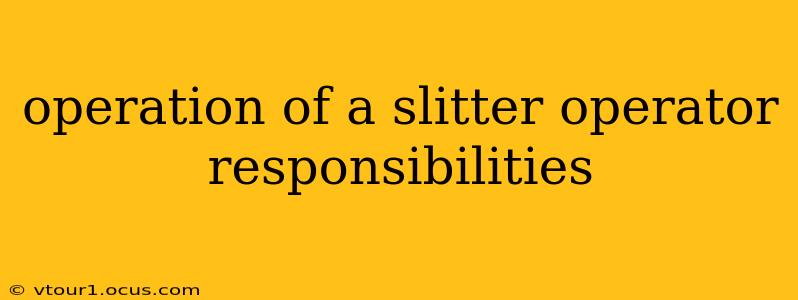A slitter operator plays a crucial role in the manufacturing process, ensuring the precise and efficient cutting of materials like paper, film, foil, and fabric into smaller rolls or sheets. This job demands a combination of technical skills, attention to detail, and adherence to safety regulations. Let's delve into the core responsibilities and essential skills required for this important position.
What are the Main Responsibilities of a Slitter Operator?
The primary responsibility of a slitter operator centers around operating and maintaining the slitter machine to produce high-quality, accurately sized slit rolls or sheets. This involves several key tasks:
- Setting up the Slitter: This includes loading the machine with the raw material roll, adjusting the blade settings according to specifications (often determined by a provided cutting diagram), and configuring the rewinding system. Precision is critical here; incorrect settings can lead to waste or damaged product.
- Operating the Slitter: Once set up, the operator monitors the machine during the slitting process, ensuring smooth operation and identifying any potential issues like blade misalignment, material jams, or inconsistencies in the final product. They may also adjust settings on the fly to maintain quality.
- Quality Control: Regularly inspecting the slit product for defects, such as uneven cuts, tears, or scratches, is a crucial part of the job. Identifying and rectifying issues promptly prevents larger problems down the line.
- Maintenance and Cleaning: Slitter operators are often responsible for basic maintenance tasks, including cleaning the machine, lubricating moving parts, and reporting any mechanical problems to maintenance personnel. Proper upkeep helps prolong the lifespan of the equipment and maintain production efficiency.
- Following Safety Procedures: This includes wearing appropriate personal protective equipment (PPE), such as safety glasses and gloves, and adhering to all company safety policies to prevent accidents. Safe operation of heavy machinery is paramount.
- Record Keeping: Many slitter operators maintain detailed records of production runs, including material used, quantity produced, and any quality control issues encountered. This data is essential for tracking performance and identifying areas for improvement.
- Troubleshooting: Identifying and resolving minor issues with the slitter machine is a common task. More complex problems are usually reported to maintenance staff.
What are the Essential Skills of a Slitter Operator?
Beyond the core responsibilities, several key skills significantly enhance a slitter operator's effectiveness:
- Mechanical Aptitude: A solid understanding of machinery and how it functions is essential for troubleshooting issues and performing basic maintenance.
- Attention to Detail: Precise measurements and careful monitoring are crucial for producing high-quality slit products. Even slight errors can result in significant waste or defects.
- Problem-Solving Skills: The ability to identify and resolve problems quickly and efficiently is critical for maintaining production flow and minimizing downtime.
- Physical Stamina: The job involves standing for extended periods, lifting and moving materials, and operating heavy machinery.
- Teamwork: Slitter operators often work as part of a larger team, so good communication and collaboration skills are important.
What are the Different Types of Slitters?
Slitters come in various types, each designed for specific materials and applications. Understanding these differences is crucial for a skilled operator:
- Rotary Slitters: These are the most common type, using rotating blades to cut the material. They offer high speed and precision.
- Sheeter Slitters: These machines cut materials into sheets instead of rolls. They are frequently used in the paper and printing industries.
- Combination Slitters and Rewinders: These machines combine slitting and rewinding capabilities, simplifying the process and improving efficiency.
What are the Safety Precautions for Operating a Slitter?
Safety is paramount when operating a slitter. Key precautions include:
- Proper PPE: Always wear safety glasses, gloves, and other appropriate protective gear.
- Machine Guards: Ensure all safety guards are in place and functioning correctly before operating the machine.
- Lockout/Tagout Procedures: Follow established lockout/tagout procedures before performing any maintenance or repairs.
- Awareness of Moving Parts: Maintain a safe distance from moving parts of the machine to avoid injury.
- Regular Inspections: Regularly inspect the machine for any signs of damage or wear and tear.
This comprehensive overview provides a thorough understanding of the responsibilities and skills required to become a successful slitter operator. Remember, continuous learning and attention to detail are key to mastering this vital role in manufacturing.
